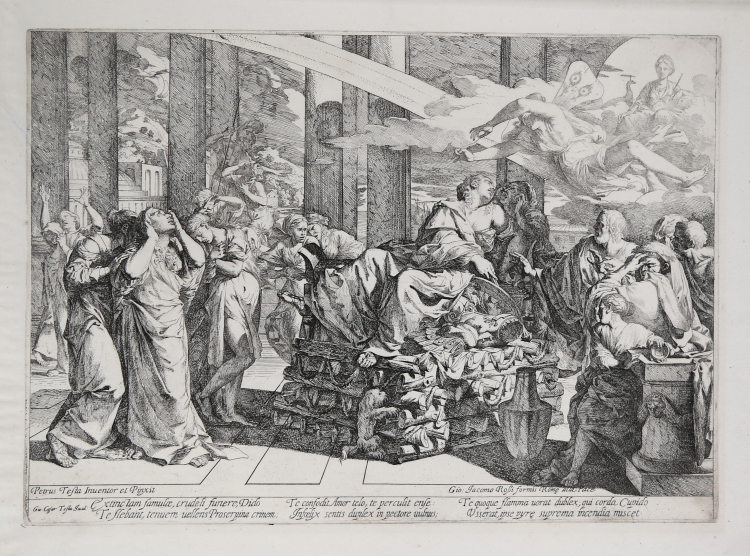




| Reference: | S31242 |
| Author | Giovanni Cesare TESTA |
| Year: | 1650 ca. |
| Measures: | 460 x 330 mm |



| Reference: | S31242 |
| Author | Giovanni Cesare TESTA |
| Year: | 1650 ca. |
| Measures: | 460 x 330 mm |
Etching, 1650/55 circa, signed at lower left.
After a subject of Pietro Testa.
Example of the first state, published by Giovanni Giacomo de’ Rossi.
Magnificent work with rich shades, printed on contemporary laid paper with “fleur de lys in a circle” watermark, with uncommon wide margins, perfectly repaired paper tear on the left, otherwise in perfect condition.
The composition depicts the dead body of Dido on a funeral pile, where can also be seen the suit of armour of Aeneas; all around, the maidservants are crying, while, in the background, the boats of the Roman hero are leaving Carthage. On upper right, there is Juno sending her female herald Iris to cut a lock of Dido’s hair, so that her soul can leave the body. The years after 1640 have been strongly influenced by Pietro Testa’s opinion about suicide. There are many famous studies about this topic, beside the Suicide of Cato, engraved by Lucchesino in 1648. After Pietro Testa untimely death, in 1650, the composition of Dido was quite ready, as the many preparatory drawings show. The painting recalled in the etching is very likely the one kept in the Uffizi, irreparably damaged. Nevertheless, it allows us to understand the preparatory drawings were realized for the print and not for the painting.
Excellent example.
|
E. Cropper, Pietro Testa Prints and Drawings, pp. 268/70, 125; Nagler 11.
|
Giovanni Cesare TESTA (Roma circa 1630 – circa 1655)
|
Nephew of Pietro Testa. He devoted himself to the art of etching. After the death of his uncle, probably to commercially exploit the market demand for his works, he worked after his drawings, with the assistance of Francois Collignon.
|
|
E. Cropper, Pietro Testa Prints and Drawings, pp. 268/70, 125; Nagler 11.
|
Giovanni Cesare TESTA (Roma circa 1630 – circa 1655)
|
Nephew of Pietro Testa. He devoted himself to the art of etching. After the death of his uncle, probably to commercially exploit the market demand for his works, he worked after his drawings, with the assistance of Francois Collignon.
|